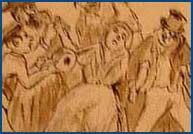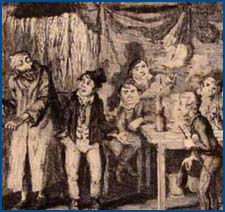|
When Is a Book Not a Book? Oliver Twist in Context Section 5. The Impact of Readers' ResponsesWith regard to the last topic, reception, the difference is obvious: a novel issued in book form as a "material whole" on a single publication date gets reviewed after the text has been written and printed; serial fiction, which appears periodically in small sections over months or years, tends to get reviewed as each installment is published. Thus amateur and professional readers of serial fiction are encouraged to speculate about the story and the characters, to project the future, and to offer the writer advice. Moreover, magazine fictions are, as we have seen in the case of Oliver Twist, frequently dramatized before completion. Readers often bombard the producers of the periodical or the fiction with suggestions for changes, some of which might be adopted, others resisted, so that the narrative, by a kind of back-formation, could revise its own previous trajectory in the course of subsequent installments. (A good example of this back-formation is Charles Dickens's making amends in David Copperfield to the outraged original of Miss Mowcher by changing the character in the middle of serialization from a procuress into a nemesis—another instance of William Maginn's thesis that outside the plot a villain may be exemplary.) Thus readers of serial fiction could exert influence on the narrative as it was being composed, something readers of books usually cannot do. There is another way that serial fictions can be affected by serial responses. When a magazine serial becomes popular, it gets copied, imitated, pirated, plagiarized, often before the story has been completed in manuscript, much less in print. Such imitations and anticipations rob the original producers of the story of some of their revenue and some of their options, both for the story and for merchandising the product. Hence Dickens and others were deeply concerned, when Oliver Twist was being published, about passing legislation to strengthen copyright. As Mark Rose reminds us in his excellent book on copyright, Authors and Owners: The Invention of Copyright (1993), plagiarism is Latin for kidnapped—a plagiarist appropriates the offspring of a creator's body, the text, just as a kidnapper appropriates the offspring of a parent's body, the child.Dickens resented his stories' being taken over by others—his publishers, dramatists, rival authors, foreign publishing houses. He objected to losing money, to having his story mangled by incompetents, to finding his climaxes anticipated, and to enriching others by his imagination and industry. Dickens's resentment, which he shared with many authors and publishers, found its way into his story of an orphan boy whose identity is stolen at birth by a legion of kidnappers who take Oliver's story and make it their own. Oliver's half-brother Monks tries to ruin Oliver's mother's reputation by rewriting it, and to invoke those clauses in the paternal will that would disinherit Oliver by rewriting him as a criminal. Nancy stages a public scene in which Oliver is her naughty brother, and more privately she tries to make him her son, a reinscription of his identity and relationship to Nancy that drives Sikes mad with jealousy. Giles and Brittles, the Maylies' servants, and the surgeon who attends the wounded boy aver that Oliver is a thief. Even Mr. Brownlow constructs many stories about Oliver, sometimes agreeing with Grimwig and Bumble, before he puts together the true narrative of Oliver's past. The story of Oliver Twist, therefore, is not just about the loss of personal and familial identity and legitimacy and inheritance. It also absorbs Dickens's and his age's preoccupation with losing control over one's own story, having it kidnapped—plagiarized—by others. The very popularity of serials made them vulnerable to commercial highwaymen who hijacked them for their own profit. Summarizing the nature of serialized fiction We have looked at four areas of difference between novels designed to be produced as books and serialized fiction. Serials tend to be multiple-authored, being constructed by the producers, editors, and other contributors to the magazine in which they appear. Serials have permeable generic boundaries, incorporating a miscellany of literary genres and appealing to readers in ways more dynamic and theatrical than contemplative. Serial fictions are topical both specifically and more generally; annotated editions for modern classroom use often pick up particular references but neglect the general ideological and aesthetic resonances. And serials interact, during the course of production, with a wide variety of readers whose responses impact successive installments. When magazine fictions are repackaged as books, these points are often obscured or denied or canceled. The result, in case after case of which Oliver Twist is only one example, is a significant distortion of the history of the book. To respond to the interrogative title of this presentation, "When is a book not a book?" one answer is, "When it is a serial." And that can make all the difference.
|


